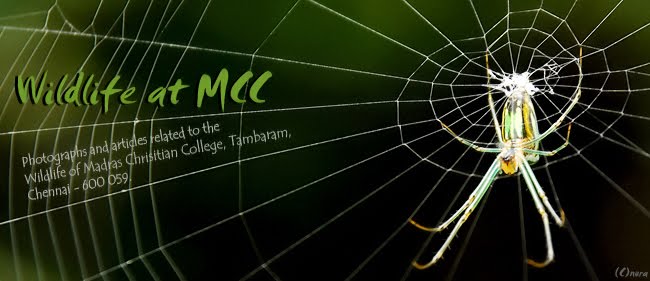Dogs and Deer
Renowned for being a jungle of sorts, the MCC campus has a fond appreciation for its spotted deer Axix axis and an equal grudge against feral dogs. Against ideas of an introduced pair of Deer or some which had made their way into the college from the Air force campus, the population of these deer have come a long way.
According to the recent census(2008-2009) conducted by the members of the Scrub Society, an average of 94 deer has been established. Among them 29 males were identified and the rest, females and fawn.
Dogs are either thrown into the campus by locals or they stray in; attracted by the food, area and mates. Some grow fond of human company while others move around in packs or even solitarily. Stray rumors and cases of dog bites have been reported especially during the late evenings and nights. Many rabid dogs have also been noticed. In 2006, most dogs were sniped down in the dead of the night. After receiving severe resistance for such eradication practices the college lay down this practice.
Being domesticated for years from the lineage of wolves, dogs instinctively chase any deer in sight with an aim to kill. They often group into packs surrounding the deer in a haphazard “V”. Using such tactics they often bring down does and especially fawns being a soft target once isolated from the group. However the dogs do not feed on the deer other than the small chunks off the behind.A total of 33 dogs were counted throughout the campus along with the deer census. This establishes the alarming ratio of 3:1, favoring deer in the campus.
Deer idealizing every bit of the word “Innocence” have destroyed large areas of our scrub jungle and for a large part responsible for the thinning of our once heavily dense campus. The large number of deer, which are primarily herbivores (individuals eating meat especially beef off the halls’ leftovers and off liberal students) feed on the tender leaves undergrowth and the emerging vegetation, which has resulted in the degradation.
Men in the campus chase or pelt the dogs with stones on seeing them chase Deer. But is such an action necessary? Even if the deer escapes another will surely die due to the large numbers. Practically it would do our college’s vegetation and in turn other animals inhabiting it, much relief as the reduction in forest cover reduces food supply to many others. This imbalance could however be rectified if a natural predator was present. The meekly Jackals hardly attack deer fending off as a mere scavenger. Some enthusiastic students especially those in the Department of Zoology might favor the introduction of large cats to control the rising deer population. The leopard seems to be the clear favorites. However if such a method would penetrate and be accepted by even one among the administrative faculty is immensely doubted. Dogs could hence be a bizarre solution in creating the balance.
However rabid forms must be eliminated as they prove to be a direct threat to the human society. Our deer could be useful as a source for the depleting stocks in wildlife sanctuaries and parks in Tamil Nadu.
The new dump yard near the International Guest House however stands to be the only place where dogs and deer are seen together in an act of basic principle: feeding on the left over which arrives from the canteens. Someone once said, “The easiest way to win an animal’s (supposedly) heart is right through its stomach”.






